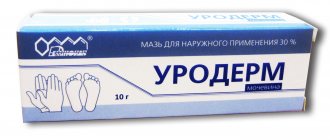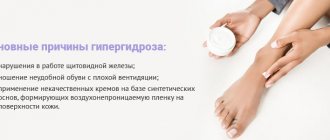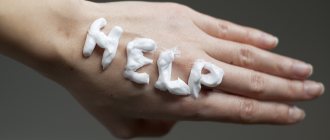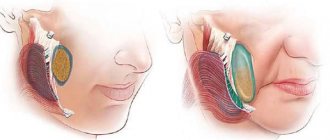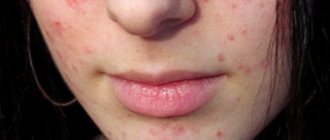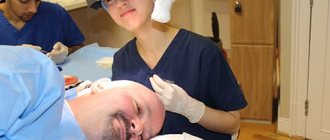Types of calluses on hands
- Dry callus.
With prolonged exposure to friction, epithelial cells turn into dense scales, layered on top of each other, and protect the diseased area from further damage. In appearance, callous tissue is dense, rough, rough, painless, and can be easily cut off with a pedicure knife. On the feet, these are usually corns. Dry calluses are difficult to deal with; over time, they reappear in the same places. - Wet callus.
It forms on more delicate and thin areas of the skin and is a bubble filled with liquid. To heal such calluses, it is enough to puncture the blister. It is not recommended to remove the skin, since in this case it serves as a biological dressing that protects against infection. Such calluses go away quickly and without leaving a trace. - Core callus.
This type of callus can be painful and cause a lot of discomfort. It appears more often on the lateral surfaces of the fingers. Horny tissue grows deeply into all layers of the epidermis, irritating nerve endings and causing discomfort. Dry callus is the most difficult to treat.
Indications and contraindications
Before using a silicone patch for calluses on your feet, you should read the instructions, including indications and contraindications for its use.
The patch should be used in the following cases:
- as soon as the callus is discovered;
- if the formation is accompanied by discomfort and pain;
- at risk of a crack;
- to protect the lesion from infection.
Contraindications for use are the presence near the callus:
- cracks;
- open wounds;
- scratches and bruises;
- papillomas and moles.
Components that impregnate the patch can cause negative reactions on open wounds - pain, burning, swelling, etc.
Causes of calluses on hands
Dry calluses appear on the hands from constant mechanical stress (pressure). Most often they affect shoemakers, dishwashers, janitors, drivers and all workers who perform the same work with tools every day. Also, gymnasts and guitarists who use palm surfaces in their profession cannot avoid calluses.
Dealing with dry calluses is very difficult; it is much easier to prevent their appearance. The favorite location for calluses is the base of the fingers. Calluses on the index and middle fingers from pressure with a ballpoint pen (among students and teachers) are also common.
Based on the location of calluses on the fingers, one can sometimes determine the type of human activity. For example, a janitor and driver often have calluses under the base of the 2nd, 3rd and 4th fingers. Programmers have it on their pads, packagers have it on their thumb, and teachers have it on their middle finger.
What ways can you remove calluses on your hands?
2. Reasons
The immediate cause of the formation of calluses on the skin is a local mechanical effect, stereotypical in nature (repeated friction, vibrating pressure, etc.). If in a given area the combination of intensity and duration of such exposure exceeds a certain threshold of strength, stability, and density of the skin, the cellular layers are damaged, regenerative mechanisms do not have time to restore the tissue, and certain pathological changes begin in it, which, again, depend on the strength , duration and vectors of mechanical irritation.
With strong friction, unusual for any area, a callus can form and spontaneously open in a matter of minutes; on the contrary, with soft, almost imperceptible, but constant pressure and rubbing, years may pass until the skin thickens and hardens adequately to the impact. In general, the adaptive capabilities of skin tissue are very great: it can adapt (hardening, as they say, to stone hardness) even to oars, a shovel or a heavy lumberjack axe.
The most typical origin of calluses is working with hand tools and equipment, playing musical instruments (especially stringed ones), and regular training on sports equipment. An extensive and diverse group is also formed by calluses associated with shoes: improperly selected, tight or too loose shoes that do not correspond to individual orthopedic features (flat feet, high instep, joint inflammation, etc.), rough and simply poorly cut and sewn shoes can become cause serious problems.
Visit our Therapy page
Treatment of calluses
- It is advisable to perform daily hand hygiene procedures. To do this, use hot baths with sea salt or essential oils for 10-15 minutes. This time is enough to steam a young soft callus. Then the keratinized tissue is cleaned off with pumice or a special brush with an abrasive coating. After removing the surface layers of dry callus, you can use a body scrub and finally apply a rich cream (you can use a baby cream). By the way, baby creams contain panthenol, which perfectly protects and heals the skin.
- You can get rid of dry, rough calluses on your hands using solutions of chemicals: trichloroacetic and formic acid and urea. The latter have a keratolytic softening effect. After their use, the callus becomes loose, turns white and can be easily removed with a pedicure knife or pumice stone. Today, pharmacies sell a large number of products for removing calluses in the form of patches and solutions for home use.
- Once every 2 months, it is advisable to visit a cosmetology office and have dry calluses removed using a specialist’s hardware method. In addition to the direct impact on the keratinized skin, the cosmetologist will treat the problem area of the hands with special creams and perform a massage. Regular paraffin baths and massaging your palms will improve blood flow and metabolism in the skin and prevent the further appearance of dry calluses.
- At home, you can make hot wraps with vegetable oils (peach and wheat germ) for a few minutes. This method is good for removing small calluses.
Methods to Prevent Calluses Formation
To reduce the likelihood of calluses, you should:
- Exercise the correct grip while practicing on the horizontal bar. You need to grasp the bar with your fingers, and not clasp it with your entire palm. With this grip, there is more stress on the fingers, hands and forearms, but the palm is less damaged.
- Choose crossbars with a large diameter for training. The thicker the horizontal bar or bar, the wider the grip area between the hand and the sports equipment and the less pressure exerted on the skin. If there is no thick bar or wide bar nearby, you can increase the thickness of the projectile yourself using a bar extender purchased at a sporting goods store or a wrapped towel.
- Use specialized gloves. They are equipped with additional lining at the base of the fingers, i.e. in areas that are most susceptible to the formation of calluses. Gloves are available in several types, differing in the degree of grip. To perform static exercises - regular pull-ups, you need to purchase gloves with a high degree of grip. If you will be performing exercises on the horizontal bar that require turning your arms, you need gloves with a low degree of grip.
- Regularly moisturize your skin by applying cream to your hands. Dry skin is prone to calluses and cracking.
- Use special hand pads. You can purchase branded leather pads or make them yourself from adhesive patches.
- Rest. During training, you need to take breaks and give your palms a few seconds of rest.
- Use magnesium. Magnesia is a powder made from magnesium salts. It is actively used in sports, as it increases friction and reduces sweating in the palms. Magnesia dries out the skin, so after training with it, you need to wash your hands and apply moisturizer to them.
Note! Using large amounts of powdered magnesia in small enclosed spaces has a negative effect on human lungs
Preventing calluses
When working, you must use protective gloves, talc, glycerin or panthenol cream. Don't forget about regular hygiene procedures. Keep your hands clean and apply a rich cream at night. At the initial signs of the appearance of calluses, use the above methods to combat them. The main thing is to prevent the formation of large, rough, dry calluses, which will be extremely difficult to get rid of.
Make an appointment by phone or.
Pharmacy products
First of all, you should pay attention to pharmaceutical products for the treatment of calluses. They are suitable for emergency treatment of opened calluses, as well as for prolonged treatment
The first results are observed 1-2 days after therapy.
External preparations
The application of local preparations accelerates the process of tissue regeneration and reduces the risk of a secondary inflammatory process. Depending on the goals of therapy for various calluses, treatment of wet and dry callus is distinguished. In the first case, the goal of treatment is to prevent infection and accelerate the healing of the skin. For core and dry calluses, the drug should soften and exfoliate the affected skin, bring the core callus out.
To soften rough skin with dry calluses, the following is prescribed:
salicylic acid (20%);
carbolic acid;
lactic acid (3%).
These solutions are applied locally. Before application, the skin is steamed well, rubbed with a pumice stone or a manicure file. Afterwards, apply a patch with a pre-prepared hole the size of a callus, drop in any of the compounds and seal with a second patch. This procedure can be carried out several times a day.
Treatment of callus blisters involves the use of the following medications:
Levomekol or Levomycetin (only with risks of suppuration);
cream Doctor;
Vishnevsky ointment;
zinc-salicylic paste;
Nazosol-911.
Before applying the preparations, the skin of the hands is thoroughly washed with soap, dried without damaging the structure of the bladder, treated with an antiseptic and the medicinal composition is applied.
First aid for a burst callus
It is generally considered impossible to open a callus on your own, but with proper organization of the opening there is nothing life-threatening. In addition, it is recommended to remove the blister on the hand to avoid compromising its integrity in the most inappropriate place (especially when antiseptic treatment is not possible). To remove a callus yourself, you must:
wash your hands with soap;
treat the skin with a solution of Furacilin, Chlorhexidine;
heat the needle over the candle;
pierce the bubble at the base (you can make several punctures);
wait for the liquid to come out;
treat with an antiseptic, apply a disinfectant and apply a bandage.
If the callus bursts, you should wash your hands thoroughly and treat the affected area with an antiseptic. If the skin is preserved, then under no circumstances should it be torn off. Firstly, the peel will help prevent primary infection if prompt medical care is not possible. Secondly, the risk of scar tissue formation is reduced significantly. It is unacceptable to treat a burst callus with alcohol solutions due to increased local irritation.
After antiseptic treatment, it is better to apply Levomekol or Levomycetin cream with an antibiotic to the callus. This will reduce the risk of infection, eliminate bacterial microflora, and quickly tighten the skin.
Stickers and patches
Any callus needs protection and fixation with medicinal compounds. Adhesive patches are widely used for these purposes. Pharmacy chains offer a wide range of different sticker options for any type of callus. To treat exposed callous blisters, it is enough to use a hygienic patch with antibacterial impregnation. When treating dry or core calluses, the following patches are prescribed:
Salipod. The patch contains sulfur, rubber, salicylic acid. Before gluing, the skin is steamed, the upper stratum corneum is removed, the required diameter is cut out and applied to the callus. You can apply a regular adhesive plaster on top to more securely fix the treatment layer. After two days, the patch is removed. If necessary, the procedure is repeated until the callus with the stem completely disappears.
Chinese patches. Contains propolis, hawthorn tincture, salicylic acid, scolopendra. Among the advantages are good fixing properties and less aggressive effects. Considering the plant composition, the risks of developing allergic reactions are high.
Korean patch Luxplast. The drug has many advantages: reliable fixation, waterproofness, no pain during separation. Usually, several procedures are enough to completely exfoliate the rough tissue of the skin of the hands and remove it.
Before gluing, it is recommended to make a steaming bath for your hands with salt, essential oils, and natural herbal decoctions. After steaming, it is recommended to remove the first layer of skin from the surface of the callus using a file, scrub, or pumice stone.
Domix foot cream, softening calluses
Cosmetics manufacturer Domix has many keratolytic products in its portfolio.
Some of them are positioned as a liquid blade.
They soften the skin and prepare it for a pedicure or manicure.
The best product for removing calluses is called Stop Callus.
However, it collects a lot of negative reviews on the Internet.
Many people report that they were unable to remove calluses using the cream.
This is probably due to the fact that the product is prophylactic and not curative.
According to the instructions, Stop Callus is not intended for removing dry calluses.
This is a cream that prevents their formation in the area of constant friction.
It is applied to areas of the skin immediately before putting on uncomfortable shoes.
Contains mineral oil and plantain extract.
So it is not surprising that calluses do not go away under the influence of Domix cream.
A quick method to get rid of dry calluses
To get rid of calluses that are not amenable to other treatment methods, you can use a time-tested medicine made from boiled eggs. It will take only 3-5 days to treat the most stubborn formations.
Recipe:
Boil a fresh chicken egg. Peel carefully, being careful not to damage the film that is located between the shell and the white. Use the film immediately - it must not dry out.
With the wet side, place the removed film on the dry formation on the dermis. Place a patch on top or secure the product with a bandage compress. Leave for 5-8 hours. During this time, the film will dry, effectively softening the callus. After removing the product, walk over the affected areas of the dermis with fine pumice - most of the callus will be completely removed.
Aquapeeling cream for calluses and corns
The name Aquapeeling hides a whole series of cosmetic products.
This product is for pedicure, hand and foot creams, and cream paste for corns.
Aquapeeling solution is available in 150 ml bottles.
The kit includes a scraper for treating the skin after using a cosmetic product.
Manufacturers promise the effect in 15 minutes.
Contains:
- potassium hydroxide
- sodium tetraborate
- aloe
The product can be used for hyperkeratic foot fungus.
It has not only exfoliating, but also an aseptic effect (kills germs).
How to use:
- Place plastic wrap on the floor - the size should be sufficient to wrap the entire foot.
- Place a napkin on top of the film and soak it with Aqua Peeling.
- Wrap your foot for 20 minutes.
- Remove the film with a napkin.
- Scrape off softened skin.
- Wash your foot.
Foot cream is an alternative to solution.
But this remedy does not work so quickly.
It is proposed to eliminate calluses with its help within 7 days.
The main component is urea.
Its concentration in the cream is 25%.
Other substances are plant extracts:
- lavender
- mint
- eucalyptus
- daisies
- green tea
These are auxiliary products to reduce skin inflammation and eliminate odor.
The product is useful for caring for rough skin of the feet with cracks.
Cream paste for corns and calluses is a more effective remedy due to increasing the urea content to 40%.
The effect can be achieved in one application.
The product is applied to the skin before bedtime.
You need to glue a patch on top.
In the morning, the patch is removed and the callus is removed with a scraper.
If it was not possible to completely remove it the first time due to its large thickness or density, the procedure is repeated.
If necessary, it can be repeated many times.
Hand cream – removes calluses and dry skin on hands.
Contains 15% urea concentration.
Additionally the composition includes oils:
- lemon
- tangerine
- shi
- almond
Aqua peeling for hands includes aloe, vitamin E and dexpanthenol.

